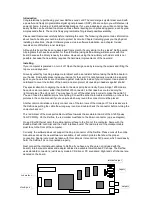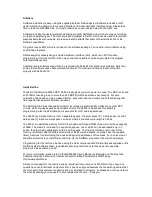
Software
Software installation is easy using the supplied installer. Delfina System Software includes a lot of
useful material in addition to the required libraries and Audio Hardware Interface driver. Please take
time to read the README files. On most occasions you can receive help with the HELP key.
Software includes the useful preferences/mixing program DelfPrefs, with which you may set volumes,
microphone amplifying etc. The most impressive program is DelFX, which can be used to record and
playback samples with versatile, impressive realtime effects that show off a small selection of the
Delfina’s capabilities.
Programs require MUI, which is included in the software package. You need to install it before using
any Delfina programs.
Delfina supports natively Amiga's Audio Hardware Interface (AHI), which is an API for audio
programming. Currently Delfina is the only sound card capable of producing multiple AHI program
outputs simultaneously.
Additional audio software support can be received with Delfina's toccata.library emulation. Note that
some older software uses undocumented functions of Toccata sound card and will not function
properly with Delfina1200.
Inside Delfina
Thanks to the Motorola 56002 DSP, Delfina really gives you more power in sound. The DSP is clocked
at 67,7MHz, resulting in up to more than 200 MOPS (million operations per second). For pure
calculation, the speed can be increased further, but sound input and output are inhibited during that
time (special development software required).
The Motorola DSP was choosed primarily for its unique programmability. Unlike many other DSP
circuits, which require expensive development tools, the 56002 is well suited for assembly
programming. Also the 24bit data bus is excellent for HI-FI audio applications.
The 56002 can access memory from 3 separate spaces: Program space (P), X data space (X) and Y
data space (Y). Each memory space can be at most 64 K-words, word length is 24 bits.
The 24bit zero wait state memory for DSP is provided with three SRAM chips, which all have capacity
of 32kB. The memory is divided to 2 equal size spaces, one of which can be addressed only in Y
space, the other being available to both P and X spaces. The division method or amount of total
memory is different with the different revisions of Delfina sound boards, so please use the supplied
library functions for determining the sizes and beginning addresses of free areas. For a quick view of
allocable memories in your Delfina sound card, try the DelfMem program at the command prompt.
Programming for the card can be done using the A56 compiler and the Delfina libraries supplied on the
Delfina System Software disks. Included are also programmer's help files and some example
programs in 56k assembly and C.
For more information, please refer to the DSP56002 User's Manual by Motorola and the help files.
Additional help can be found on Internet at Petsoff Limited Partnership's WWW page
http://www.petsoff.com
All technical support for the card is done by individual Computers, Jens Schönfeld. If you have any
questions, consult individual Computers first. It has been agreed between the cooperating parties that
the main part of the customer support is done by individual Computers, so please don’t cause us twice
the work by sending your requests to both companies at a time - thank you.





















